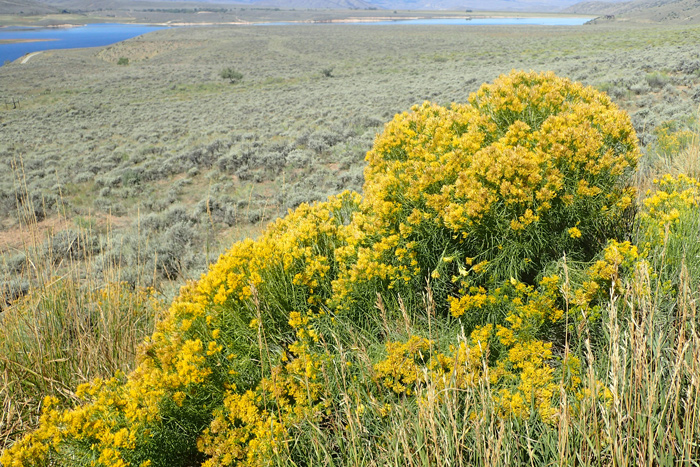Rubber Rabbitbrush
- Ericameria nauseosa (Pall. ex Pursh) G.L. Nesom & Baird
- Aster family (Asteraceae)
Narration:
General Information
- Plants: Shrubs 1 to 3 feet tall. Twigs covered with dense, white, felt-like hair. Leaves narrow, less than 2 1/2 inches long, grayish green in color.
- Flowers: Rayless heads with five yellow disk flowers per head. Bracts keeled and overlapping in vertical rows.
- Fruits: Achenes with pappus of slender, hair-like bristles.
- Flowering Season: June to September.
- Habitat/Range: Dry grasslands and open woods of plains, valleys, and foothills from southern British Columbia to Saskatchewan and south to California, Texas, and southern Mexico.1
Blackfeet Ethnobotany*
by Darnell and Smokey Rides At The Door
The Blackfeet name for rubber rabbitbrush is A Aat Tis Sta Otsi Piis. It translates to 'rabbit willow.' The plant was used as feed for horses, and the heads of the flowers can be turned into a yellow dye, most often used for painting rawhide suitcases, called parfleches, shields, or cylinders.2
From the Journals
by H. Wayne Phillips
There are six specimens of rubber rabbitbrush in the Lewis and Clark Herbarium, more than any other species, and the specimens still exist in the Academy of Natural Sciences in Philadelphia.3 The explorers collected two of the specimens on September 21, 1804, on the “Big Bend” of the Missouri River in either the present-day Crow Creek or Lower Brule Indian Reservation below Pierre, South Dakota.
We believe they collected two additional specimens on October 2, 1804, above the mouth of the Cheyenne River in the present-day Cheyenne River Indian Reservation above Pierre. We think they collected the final two specimens in October 1804 in either North or South Dakota, but the exact place and date are unknown.
Original labels associated with two other specimens, in Lewis’s handwriting, provide some interesting information:
No. 32. Specimens of aromatic plants on which the a[n]telope feeds—these were obtained 21st of Sept. 1805 [1804]. at the upper part of the bigg bend of the Missouri . . . No. 54. October 2ed—grows from 18 inches to 2 1/2 feet, many stalks from the same root, from which they issue near the groun[d]—the radix [root] perennial. The goat or antelope feed on it in the winter. It is the growth of the high bluffs.4
Additional Information: During World War I, the rubber rabbitbrush was tested as a reliable and hardy source of rubber, and though for several decades was not explored farther, it is now being tested again for potential rubber uses. It more recently has been tested for potential anti-malarial properties, resins, natural insecticides, biomass, and biocrude fuels.
The scientific species name comes from the smell that is released when the flowers are crushed. Some compare the smell to pineapple, others to rubber. Many small mammals use the plant for cover, and larger mammals feed off of it.5
*While traditional medicine is still practiced in many cultures including the Blackfeet culture and has many uses, please do not consume any plant material without consultation of a health professional.

Big Foot Pass in Badlands National Park, South Dakota. © 2016 by Krzysztof Ziarnek, Kenraiz. Permission to use granted under the Creative Commons Attribution-Share Alike 4.0 International license.

Williams Fork Reservoir, Colorado. © 2016 by Wikimedia Commons user Kenraiz. Permission to use granted under the Creative Commons Attribution-Share Alike 4.0 International license.
Notes
- "Ericameria nauseosa (Pall. ex Pursh) G.L. Nesom & Baird," United States Department of Agriculture Natural Resources Conservation Service Plant Database, plants.usda.gov/home/plantProfile?symbol=ERNA10.
- All ethnobotanical information was given or verified by Smokey Rides At The Door and Darnell Rides At The Door. Initial research came from Native American Ethnobotany Database. Please be advised that not all studies included are correct and to consult with Native community members to verify information.
- H. Wayne Phillips, Plants of the Lewis and Clark Expedition (Missoula, Montana: Mountain Press Publishing Company, 2003). H. Wayne Phillips graciously donated his expertise on this subject by writing this narrative.
- The Definitive Journals of Lewis & Clark, Gary Moulton, ed.
- Sarah Malaby, "Plant of the Week: Rubber Rabbitbrush (Ericameria nauseosa (Pall. ex Pursh) G.L. Nesom & Baird)," United States Department of Agriculture Forest Service, www.fs.usda.gov/wildflowers/plant-of-the-week/ericameria_nauseosa.shtml.


